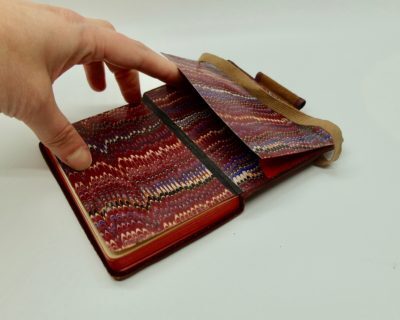For years, I’ve wanted to find an example of the original “carnets moleskine” that existed for many decades before the capital-M Moleskine brand was founded. It’s difficult to research online, as the capital-M notebooks dominate the results if you try to search any related terms. I wrote about it in a blog post a few years ago, when I actually did find an image of one of Picasso’s small notebooks.

In doing some digging on eBay, I happened to find this lovely 1898 agenda notebook, and I was very excited, because it looks exactly like the Picasso notebook I had blogged about. I had also seen a similar notebook in a museum, I think belonging to Matisse. Perhaps the notebooks used by those famous artists were more often this design, rather than the black faux-leather covers so common today?

The cover is a woven fabric, with stitched edges reinforced with a faux-leather. It has an elastic closure. Inside, the endpapers are marbled, and in the back, there’s an expanding pocket. There is also a pen loop and red page edges, and the size is smaller than today’s usual standard for pocket notebooks, but it hits all the basic design elements that Moleskine later imitated. The paper inside is squared, except for a couple of signatures at the back.



Only one page at the beginning is unprinted. Then there is a page listing saints’ names for each day of the first 6 months of the year. The rest of the saints appear on a page at the back of the book. There must have been some printing reason for splitting them up.


Then the pages have dates printed, 4 days per page. The printing is kind of crooked, almost as if someone hand-stamped each page. In the back there is a page for each month, with the days listed line by line. Then there are a few pages of postal information. Finally, there is a section of information about all the prefectures and sub-prefectures in each department of France, with details on their distance from Paris, populations figures, and dates of fairs and markets. The list of departments in 1898 is slightly different from today’s, for instance still including Algeria, which was at the time a colony of France. Today, Paris is its own department, but it used to be the prefecture of the Seine department. The population was 1,955,295, and that’s all they have to say about Paris. But the sub-prefecture of Sceaux is noted to have “every Monday, renowned cattle market that rivals the one in Poissy.”

This notebook was barely used. Someone jotted a few numbers on the blank page at the beginning, and used the December page to write a list of words. At first glance, I thought it might be a shopping list, or a business person’s list of products for sale, since some of the words were basic items like “gasoline” and “oil.”

Reading more closely, some of the words seemed to be colors, and then I noticed “varnish,” “brushes,” and some terms I had to look up, which seemed to relate to architectural motifs and framing. “Essence” could mean “turpentine” rather than “gasoline,” and “Ripolin” is a brand of paint, so I realized that this notebook must have belonged to an artist! The Wikipedia entry for Ripolin even says that Picasso was known to have used that brand. Maybe I have an actual Picasso small-M carnet moleskine! (Which would have been even more exciting than buying Dora Maar’s address book on eBay!) I rather doubt it, especially as Picasso first went to Paris in 1900, but I suppose it could have belonged to some artist who moved in the same circles as Picasso and Matisse. Whoever it belonged to, I’m glad I have this fascinating notebook in my collection!

Fabulous find!
Congrats! What a find!
How cool! Louise of the Forever French Etsy store often has cool French agendas, but I’ve never seen one quite like this.
Amazing! I don’t know if you saw Herzog’s documentary Nomad, about his friendship with Chatwin. You can see several pics of Chatwin’s carnets, and at the end, Werner holds his friend’s last moleskine.